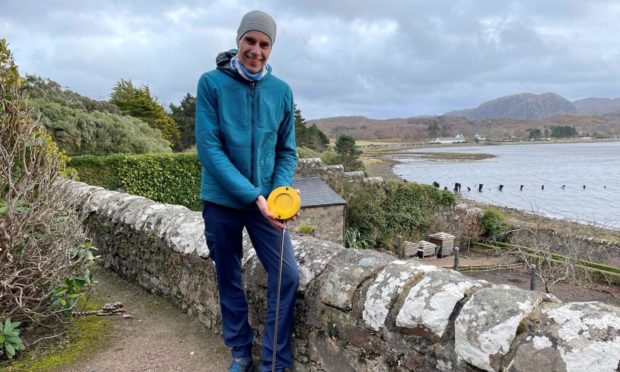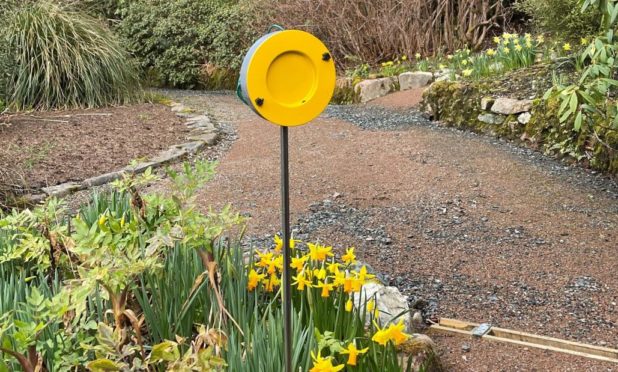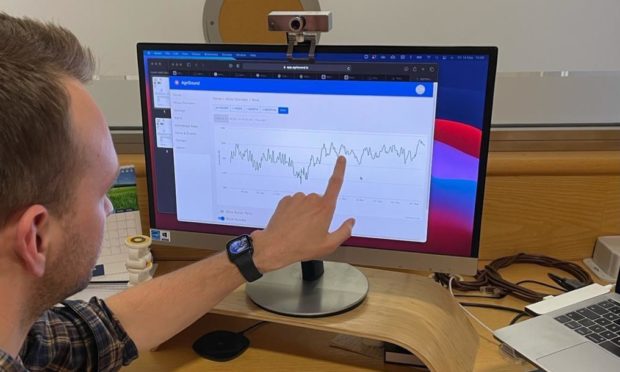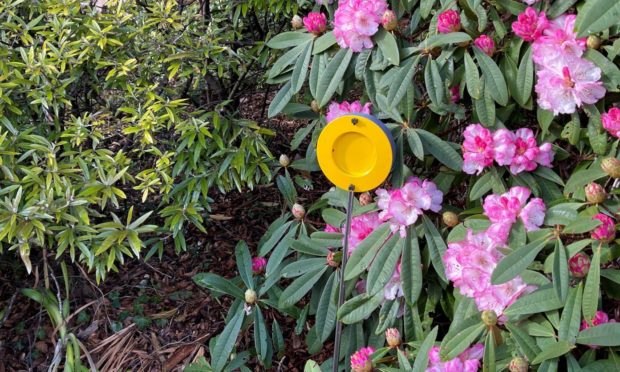Inverewe Garden is full of exotic species, including some that shouldn’t grow in the north-west of Scotland.
But a new addition to the renowned displays stands out more than the rest and will play a crucial role in protecting and growing the garden in future.
In a UK first, the garden, which is run by the National Trust for Scotland (NTS), is installing a series of pollinator counters to measure the number of insects, particularly bees, that visit the famous attraction amid concern about declining numbers.
‘Heat map’ will show which plants insects are visiting
Up to 30 of the brightly-coloured devices, designed to mimic flowers, have been ‘planted’ strategically around the 55-acre site with each insect ‘hit’ being picked up and recorded when it breaks an infra-red beam inside.
NTS staff and their partners in the project, AgriSound, will then be able to create a “heat map” of the plants and flowers different insects are visiting most and least.
Amateur gardeners will also be able to follow the insect visits as they happen on a screen in the garden visitor centre.
Inverewe is trialling the counters ahead of International Biodiversity Day on Saturday.
It is hoped the information will provide data to help professional and amateur gardeners plan ahead as pollinator numbers decline due to factors including climate change.
The garden’s operations manager Martin Hughes partnered on the project with Yorkshire-based AgriSound, which set up only last year, through a mutual friend.
‘Data is essential for the garden to survive’
He said: “The data we get at the moment is pretty poor but we are hoping this will transform the way we look at insect visitation in the garden which is essential for it to survive going forward.
“No one else is looking at this at the moment.
“The information goes straight to the internet, so in real time we can see where the visitation is in the garden.
“We will be able to display that on TVs in the visitor centre so customers will also get a feel for what’s going on.
“We have a weather station here so will be able to cross reference what the insects do by weather as well. Using this data we hope we will be able to establish which plants in the garden are really great pollinators and how we use those to encourage even more pollinators to come to Inverewe and help us pollinate the other plants.”
Mr Hughes added: “We don’t know what our visitation numbers are here, but the general trend across Europe is that it’s going down.
“For the first time this allows us to get a clear picture of exactly what’s happening in the garden. We also hope the data we get will inspire other gardens in the trust, as well as elsewhere in Scotland and the UK, to help them combat climate change.”
Inverewe Garden, north of Poolewe in Wester Ross, was created from barren land in 1862 by Osgood Mackenzie.
Despite being at the same latitude as Moscow and Hudson Bay, Inverewe benefits from a unique garden microclimate due to the effects of the Gulf Stream which allowed it to grow more than 2,500 exotic plants and flowers.
Casey Woodward, founder and CEO of AgriSound, said it is the ideal location to trial the device: “It’s really exciting for us. We hope the project will give us really interesting data on how the devices perform and the garden will get data on the distribution of pollinators.
Project could benefit amateur gardeners
“It’s an accelerated trial site in a lot of ways because the diversity of plants there is pretty unparalleled so it creates a great site for some good science.”
He said the trial could have implications for amateur gardeners: “We hope to give lots of people over the summer the chance to see the device in action.
“It’s then our ambition to make it available to gardeners and environmental enthusiasts who want to play a part in protecting pollinators who can use the device in their garden or flowerbox.”
In response to falling numbers, The Pollinator Strategy for Scotland 2017-2027, led by NatureScot, aims to address the causes of decline in populations, diversity and range of pollinator species and help them thrive.
It highlighted pressures such as habitat loss and fragmentation, changes in land use, disease, pesticides and climate change.
Entries gathered through BeeWatch, a UK-wide citizen scientist programme, will inform compilers of bumblebee-specific lists of plants and flowers, helping them prepare more specific pollinator plant recommendations.



